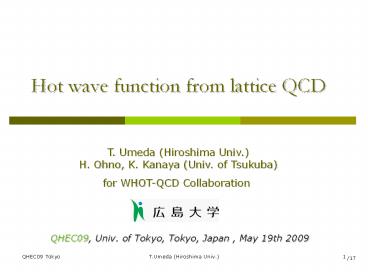Hot wave function from lattice QCD - PowerPoint PPT Presentation
Title:
Hot wave function from lattice QCD
Description:
Hot wave function from lattice QCD T. Umeda (Hiroshima Univ.) H. Ohno, K. Kanaya (Univ. of Tsukuba) for WHOT-QCD Collaboration QHEC09, Univ. of Tokyo, Tokyo, Japan ... – PowerPoint PPT presentation
Number of Views:123
Avg rating:3.0/5.0
Title: Hot wave function from lattice QCD
1
Hot wave function from lattice QCD
T. Umeda (Hiroshima Univ.) H. Ohno, K. Kanaya
(Univ. of Tsukuba) for WHOT-QCD Collaboration
QHEC09, Univ. of Tokyo, Tokyo, Japan , May 19th
2009
/17
2
Contents of this talk
from the Phenix group web-site
- Introduction
- -- Quark Gluon Plasma J/? suppression
- -- Lattice studies on J/? suppression
- Our approach to study charmonium dissociation
- Charmonium wave functions at Tgt0
- Discussion Summary
/17
3
J/? suppression as a signal of QGP
Lattice QCD calculations Spectral function by
MEM T.Umeda et al.(02), S.Datta et al.(04),
AsakawaHatsuda(04), A.Jakovac et
al.(07), G.Aatz et al.(06) Wave func.
T.Umeda et al.(00) B. C. dep. H.Iida et al.
(06) ? all calculations conclude that J/?
survives till 1.5Tc or higher
/17
4
Sequential J/? suppression scenario
?
10
60
J/?
?c
AA collisions
30
E705 Collab.(93)
J/? (1S) JPC 1 M3097MeV (Vector)
? (2S) JPC 1 M3686MeV (Vector) ?c0
(1P) JPC 0 M3415MeV (Scalar) ?c1
(1P) JPC 1 M3511MeV (AxialVector)
PDG(06)
It is important to study dissociation
temperatures for not only J/? but also ?(2S),
?cs
/17
5
Hot QCD on the lattice
Lattice QCD enables us to perform
nonperturbative calculations of QCD
Path integral by Monte Carlo integration
QCD action on a lattice
- Finite T Field Theory on the lattice
- 4dim. Euclidean lattice
- gauge field Uµ(x) ? periodic B.C.
- quark field q(x) ? anti-periodic B.C.
- Temperature T1/(Nta)
/17
6
Spectral function on the lattice
Thermal hadron (charmonium) correlation functions
Spectral function
- discrete spectra
- bound states
- charmonium states
- continuum spectra
- 2-particle states
- scattering states
- melted charmonium
/17
7
Spectral functions in a finite volume
Momenta are discretized in finite (VL3)
volume pi/a 2nip/L (ni0,1,2,) for Periodic
boundary condition
bound state wave func.
scattering state wave func.
In a finite volume (e.g. Lattice simulations),
discrete spectra does not always indicate
bound states !
Shape of wave functions may be good signature
to find out the charmonium melting.
/17
8
Bound state or scattering state ?
- non-local wave function
- Vol. dependence
- local wave function
- small Vol. dependence
/17
9
Wave functions at finite temperature
Temp. dependence of ( Bethe-Salpeter ) Wave
function
- Remarks on wave function of quark-antiquark
- gauge variant ? Coulomb gauge fixing
- large components of quark/antiqaurk
- ? derivative operators for
P-wave channels
/17
10
Technique to calculate wave function at Tgt0
It is difficult to extract higher states
from lattice correlators (at Tgt0) even if
we use MEM !! It is important to investigate
a few lowest states (at Tgt0) Constant mode can
be separated by the Midpoint subtraction
T. Umeda (2007)
/17
11
Lattice setup
- Quenched approximation ( no dynamical quark
effect ) - Anisotropic lattices
- lattice spacing as 0.0970(5) fm
- anisotropy as/at 4
- rs1 to suppress doubler effects
- Variational analysis with 6 x 6 correlation matrix
t
x,y,z
/17
12
Wave functions in free quark case
Test with free quarks ( Ls/a20, ma0.17 ) in
case of S-wave channels
- Free quarks make trivial waves with
- an allowed momentum in a box
- The wave function is constructed with
- eigen functions of 6 x 6 correlators
- 6 types of Gaussian smeared operators
- f(x) exp(-Ax2),
- A 0.02, 0.05, 0.1, 0.15, 0.2, 0.25
- Our method well reproduces
- the known result ( ! )
/17
13
Charmonium wave functions at finite temperatures
- Small temperature dependence in each channels
- Clear signals of bound states even at T2.3Tc (
! ) - (2fm)3 may be small for P-wave states.
/17
14
/17
15
Volume dependence at T2.3Tc
?c1(1P)
J/?(1S)
?c1(2P)
?(2S)
- Clear signals of bound states even at T2.3Tc (
! ) - Large volume is necessary for P-wave states.
/17
16
Discussion
We found tight wave functions up to
2.3Tc for S- P- wave channels. (1) Variational
analysis works well ? wave function for
lowest/next-lowest state
contributions from higher states ?
contaminations our results suggest
there are no/small non-local wave functions
even in the higher states (!) (2)
Effects of interaction ? It may be
difficult to conclude whether bound or unbound.
in any case, tight wave function
is incompatible with the J/?
suppression (!)
/17
17
Summary and future plan
We investigated Tdis of charmonia from Lattice
QCD without Bayesian (MEM) analysis using...
- Bethe-Salpeter wave function -
Volume dependence of the wave function
-
? The result may affect the scenario of J/?
suppression.
- Future plan
- Possible scenarios for the experimental J/?
suppression - Higher Temp. calculations ( T/Tc35 )
- Full QCD calculations ( Nf21 Wilson is now in
progress )
/17































